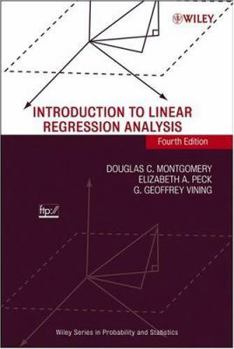Introduction to Linear Regression Analysis, 3rd Edition
Select Format
Select Condition 
Book Overview
A comprehensive and up-to-date introduction to the fundamentals of regression analysis The Fourth Edition of Introduction to Linear Regression Analysis describes both the conventional and less common uses of linear regression in the practical context of today's mathematical and scientific research. This popular book blends both theory and application to equip the reader with an understanding of the basic principles necessary to apply regression model-building techniques in a wide variety of application environments. It assumes a working knowledge of basic statistics and a familiarity with hypothesis testing and confidence intervals, as well as the normal, t, x2, and F distributions. Illustrating all of the major procedures employed by the contemporary software packages MINITAB(r), SAS(r), and S-PLUS(r), the Fourth Edition begins with a general introduction to regression modeling, including typical applications. A host of technical tools are outlined, such as basic inference procedures, introductory aspects of model adequacy checking, and polynomial regression models and their variations. The book discusses how transformations and weighted least squares can be used to resolve problems of model inadequacy and also how to deal with influential observations. Subsequent chapters discuss: * Indicator variables and the connection between regression and analysis-of-variance models * Variable selection and model-building techniques and strategies * The multicollinearity problem--its sources, effects, diagnostics, and remedial measures * Robust regression techniques such as M-estimators, and properties of robust estimators * The basics of nonlinear regression * Generalized linear models * Using SAS(r) for regression problems This book is a robust resource that offers solid methodology for statistical practitioners and professionals in the fields of engineering, physical and chemical sciences, economics, management, life and biological sciences, and the social sciences. Both the accompanying FTP site, which contains data sets, extensive problem solutions, software hints, and PowerPoint(r) slides, as well as the book's revised presentation of topics in increasing order of complexity, facilitate its use in a classroom setting. With its new exercises and structure, this book is highly recommended for upper-undergraduate and beginning graduate students in mathematics, engineering, and natural sciences. Scientists and engineers will find the book to be an excellent choice for reference and self-study.
Format:Hardcover
Language:English
ISBN:0471754951
ISBN13:9780471754954
Release Date:July 2006
Publisher:John Wiley & Sons
Length:612 Pages
Weight:2.70 lbs.
Dimensions:1.4" x 7.3" x 10.0"
Customer Reviews
5 ratings
excellent
Published by Thriftbooks.com User , 15 years ago
it saids the book is used but like new. However, the book is actually totally new, never used before,no pollution at all. The price is also one of the lowest compare with others. Excellent!!
For Self Study Get An Earlier Edition
Published by Thriftbooks.com User , 15 years ago
I have access to this, the third edition and the latest, the fourth edition, through my company's library. There is really no material difference in the content and I was able to save about 80% of the purchase price by buying a used copy of the third edition, vs. new copy of fourth edition. Wonderful book for self study. You will benefit most if you have a good background in probability theory and linear algebra and want to understand the details and language of linear regression. Even without that background chapters one through three will teach you more than you will ever learn in most survey courses in statistics. To fully appreciate the whole book I think you need a one semester course in linear algebra and one or two semesters of probability theory.
Good book
Published by Thriftbooks.com User , 15 years ago
This is a good book with good exercises in the end of the chapters, but a little hard to read.
A good book with industrial applications
Published by Thriftbooks.com User , 18 years ago
very useful for industrial applications. There are quite a few printing mistakes and that would be a problem for those reader they are not very strong in statistics.
Excellent introduction to linear regression
Published by Thriftbooks.com User , 20 years ago
If you have a desire or need to develop regression models, whether for prediction or classification, this is a great place to start climbing the learning curve. The book covers all the essentials, such as how to fit a model to a set of data, how to evaluate the quality of the fit, and how to detect influential data points. It also does a good job with some of the issues involved in fitting a regression (most notably colinearity, overfitting, outliers, and deviations from normality) and discusses ridge regression, principal components regression, and other so-called "robust" methods for dealing with such issues. Even if you plan to use nonlinear modelling techniques like polynomial regression or feed-forward neural networks, this book is worth reading: many of the same issues that are involved when developing linear regression models arise in the context of nonlinear models. I use multivariate polynomial regression models for pricing options, and cite this book in my own recent work on that subject--"Advanced Option Pricing Models" (McGraw Hill, Feb 2005). Jeffrey Owen Katz, Ph.D. Author (with Donna L. McCormick) of "The Encyclopedia of Trading Strategies" (McGraw Hill, 2000).






